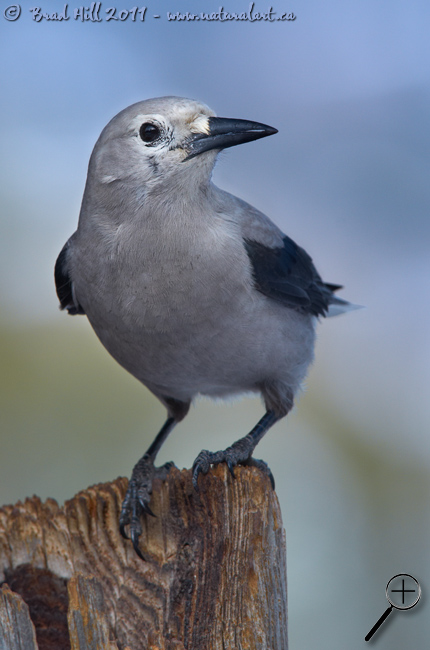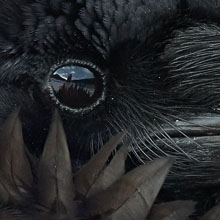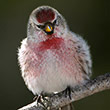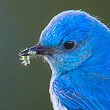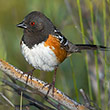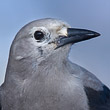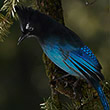Availability: Undetermined - Enquiries?
In the Field
Clark's Nutcracker - The Eye! Findlay Creek, BC, Canada. March 11, 2011.
I nabbed this shot in the midst of testing some new combinations of gear. I was actually waiting for red squirrels to show their faces when this Clark's Nutcracker landed and "eyed" me up and down (presumably hoping that I'd have a snack for it). Sorry buddy!
It would be easy to go on about the importance of eye contact or compositional principles with this shot (particularly the appeal of "S-curves"), but this image illustrates an interesting principle (or debate) about depth-of-field...
In my role as moderator of the Wildlife Gallery on the Nature Photographer's Network Online Magazine I see a lot of images and read a lot of image critiques. A number of times I've seen comments that go something like this: "Nice shot, but too bad the whole animal isn't in focus". Which leads to an interesting question and related depth-of-field (DoF) issue - should the entire animal always be in sharp focus in a photo?
Well, if you look at this image, you can probably guess my thoughts. To my eye, if this image works at all, it's largely because the viewer's attention is drawn to the sharply focused head region. And, both the soft background and slightly out-of-focus remainder of the bird help create a "focus contrast" that aids in drawing attention to the part of the image (that head region) where I want them looking.
Of course, this DOESN'T mean that ALL images of wildlife should contain out-of-focus regions on the main subject. If you're shooting animalscapes (where the subject is just a small portion of the overall scene), odds are you'll want the entire subject in focus. But...when you move in for a tight shot, controlling your DoF so that critical regions are in focus, and other regions are thrown out-of-focus, is a powerful tool to be carrying in your conceptual tool chest.
By the way - the testing I was doing during this shoot was in an effort to try to assess how well the TC-14EII (1.4x teleconverter) paired up with Nikon's 400mm f2.8 VRII lens. Secondarily I was trying to increase my bank of D7000 images (to get a better feel for how that camera performs in a variety of situations). It's always better to assess image sharpness (and noise, etc.) use high res images (compared to resolution-reduced web images), so anyone curious about the image quality can download this image:
• Clark's Nutcracker - The Eye: Half res (2464x1632 pix; 983 KB)
Behind the Camera
Clark's Nutcracker - The Eye! Findlay Creek, BC, Canada. March 11, 2011.
Digital Capture; RAW 14-bit format; ISO 250.
Nikon D7000 with Nikkor 400mm f2.8 VRII lens paired with TC-14EII 1.4x teleconverter (total effective focal length of 825mm). Supported on tripod with Wimberley head. VR on and in "Normal" mode.
1/160s @ f11; no compensation from matrix-metered exposure setting.
At the Computer
Clark's Nutcracker - The Eye! Findlay Creek, BC, Canada. March 11, 2011.
RAW Conversion to 16-bit TIFF, including first-pass/capture sharpening using Phase One's Capture One Pro 6. Three raw conversions varying in exposure settings: one at -0.5 stops to reduce brightness of background and retrieve highlight detail on eye-ring ; one at no compensation (bulk of image); and one at +0.5 stops to retrieve shadow detail on underside of bird.
Further digital corrections on 16-bit TIFF file using Adobe's Photoshop CS5 and Light Craft's LightZone. Photoshop adjustments included selective exposure adjustment, and selective sharpening for web output. Final tonemapping and contrast/tone tweaking - especially to midtones - performed with LightZone using the tonemapper/re-light tool.
Conservation
Clark's Nutcracker - The Eye! Findlay Creek, BC, Canada. March 11, 2011.
Z 7II Testing - The Curious Nutcracker. Findlay Creek Region (East Kootenays), British Columbia, Canada. December 27, 2020.
Species Status in Canada*: This species is not designated as at risk.
The Clark's Nutcracker (Nucifraga columbiana) is a nosey and noisy member of the jay family and is found in coniferous forests in the western mountains of North America. Clark's Nutcrackers feed primarily on pine seeds but show extreme flexibility in adapting to new food sources, including using bird feeders or robbing food from campgrounds.
During the breeding season Clark's Nutcrackers will defend small nesting territories against conspecifics, but for the bulk of the year they are highly social and gregarious, often forming flocks of 20 or more individuals. Although their breeding behaviour is poorly studied, it appears that they ae monogamous and likely form long-lasting pair bonds.
*as determined by COSEWIC: The Committee on the Status of Endangered Wildlife in Canada













